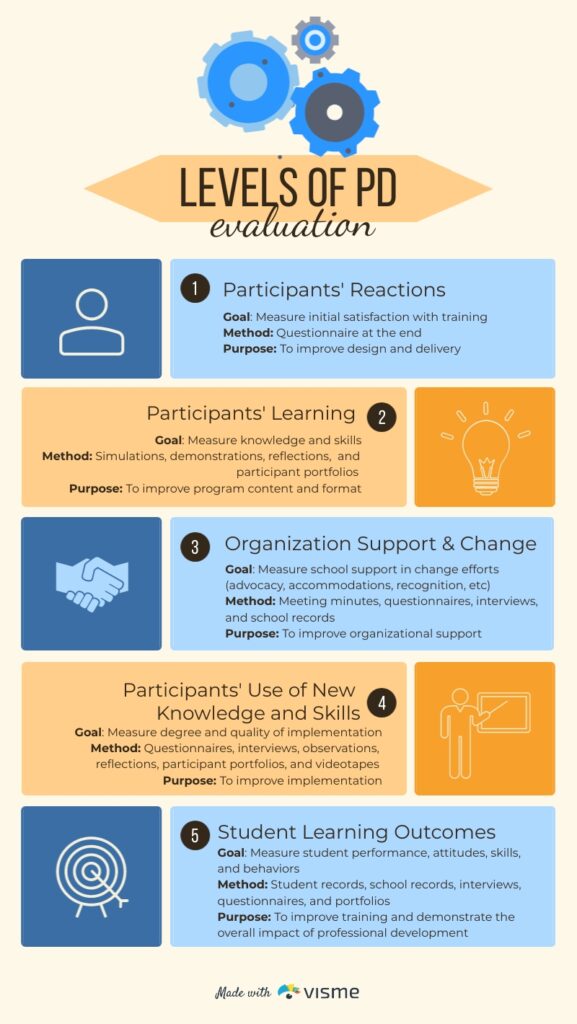
Time to Get Serious: Evaluating the Impact of Professional Learning
Okay teacher friends, we’ve all been there. You just completed some form of professional development and you’re itching to get out the door. Someone walks by and hands you that green evaluation form right at the end. You know, the one you have to complete in order to get clock hours? In my experience, there are usually some additional questions about how the training went so that the facilitator can glean feedback on how they did. I remember jotting down some notes as fast as I could (while still being legible) so that I could jet out the door.
I’ve participated in a spectrum of professional learning sessions. From big international technology conferences to small local ESD workshops and in-house training on a specific topic. I feel like I’ve “been around the block” and done everything from PLCs and book studies to school tours and big conferences. Needless to say, I feel tremendously blessed to have been given these opportunities to explore, learn, and grow in my own skills as an educator. But how do we know if these professional learning opportunities actually made an impact? How do we measure teacher growth, the impact on student learning, or overall school-wide improvement?
ISTE Coaching Standard 5 states that coaches “Evaluate the impact of professional learning and continually make improvements in order to meet the school-wide vision for using technology for high-impact teaching and learning.”
So my big question: “How do we evaluate the impact of professional learning?”
As I highlighted in a previous blog, Righting the Ship, one of our biggest problems with professional development (PD) is that we cram too many different topics into our annual schedule and then can only follow up on one or two of them. If that! This would be like teaching a math lesson to our students and moving on before we checked for understanding. Did our students acquire the knowledge and skills they need to be successful? We need to ask the same thing of our teachers. After completing PD, there should be more than just a half sheet evaluation on how the session went. So this week I chose to dive in deep on best practices in evaluating professional learning.
There are several well-known theories on how to evaluate the effectiveness of training. Perhaps the most famous in the education realm is Guskey’s Five Levels of Professional Development Evaluation. Guskey proposed that there were 5 domains that needed to be evaluated when weighing the success of a particular training. Below is a summary of each domain and suggested tools for collecting data.

Guskey, Thomas. (2002, March). Does It Make a Difference? Evaluating Professional Development. ASCD. http://www.ascd.org/publications/educational-leadership/mar02/vol59/num06/Does-It-Make-a-Difference%C2%A2-Evaluating-Professional-Development.aspx
Guskey also had a Theory of Teacher Change. He believed that teachers needed to first see the power of the new teaching method to really believe it was effective and continue to apply it (Hanover Research, 2015). Therefore, teachers must be given the time to reflect and evaluate student learning outcomes. Then they can see the impact of their training and continue to make changes where needed to improve student learning.
PD is a complex beast. It can take many forms, whether attending workshops, participating in study groups, curriculum development, peer coaching, and so on. “But regardless of its form, professional development should be a purposeful endeavor. Through evaluation, you can determine whether these activities are achieving their purposes” (Guskey, 2002). As coaches, we cannot stop after the training, say a little prayer, and hope that we hit our mark. We owe it to ourselves and our students to follow through with Guskey’s five steps to determine if the training worked. Even if we are working alongside teachers who have individual goals and are doing more of a personalized PD structure, we can train and empower them to collect and analyze student data to take charge of their own continuous improvement cycle. Professional Learning should be an iterative cycle, where we take time to evaluate the impact on teachers, school-wide improvement, and most importantly student learning.
Works Cited
Guskey, Thomas. (2002, March). Does It Make a Difference? Evaluating Professional Development. ASCD, 59(6), 45-51. http://www.ascd.org/publications/educational-leadership/mar02/vol59/num06/Does-It-Make-a-Difference%C2%A2-Evaluating-Professional-Development.aspx
Guskey, Thomas. (2016, February). Gauge Impact With 5 Levels of Data. Learning Forward, 37(1). https://tguskey.com/wp-content/uploads/Professional-Learning-1-Gauge-Impact-with-Five-Levels-of-Data.pdf
Hanover Research. (2015, November). Best Practices In Evaluating Teacher Professional Development. Hanover Research. https://www.rsdmo.org/community/committees/professionaldevelopment/Lists/Meetings/Attachments/61/Best%20Practices%20in%20Evaluating%20Teacher%20Professional%20Development%20(1).pdf
ISTE Standards for Coaches (n.d.). Retrieved from: https://www.iste.org/standards/for-coaches



2 Comments
Megan
I really like the graphic you provided as it gives a clear picture of the 5 levels and makes it easy to understand. I wonder how as a coach I can work closer with teachers in order to help them better evaluate the impact on student outcomes? I think this is sometimes the place that teachers get stuck. It is easy to see and think of the impact it had on ones own learning but I don’t often find that we think about how the learning impact our students. I also appreciate your point about it being an iterative cycle, so how can we build this into a school community in order to truly look at impact? Thank you so much for sharing!
Jan White
Kaelynn, the description of PD being a ‘complex beast’ made me smile. And just as complex is the problem of evaluation. I agree with Meagan, the visual explanation of Guskey’s five levels of evaluation is helpful. Most evaluations I’ve participated in as a teacher have been Level One and maybe be a smidge of Level Two and Level Four. Thanks for this reminder that effective evaluation cannot be a quick exit survey and should be an intentional part of PD design. Measuring the impact of PD on student learning outcomes requires teacher vulnerability plus the space and time to implement and practice new learning. Vulnerability requires a trusting relationship; time requires patience and resilience on the part of the educator as well as coaches and administrators.